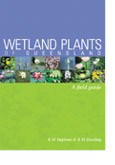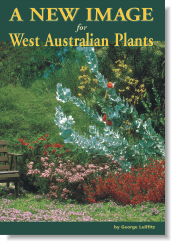|
[Front Page] [Features] [Departments] [Society Home] [Subscribe]

A Good Read
.....what's worth a look?
Reviews in this issue cover Australian Planting Design by Paul Thompson, Wetland Plants of Queensland - A Field Guide by KM Stephens and RM Dowling and A New Image for Australian Plants by George Lullfitz. |
 |

 
Australian Planting Design
Paul Thompson
Published by Lothian Books, South Melbourne, 2002
Hardback, 212 pages, 65 colour photographs, many sketches to illustrate design principles
$A65.00.
Reviewed by Tony Cavagnah
For someone starting out to design their garden, particularly if they have little knowledge of what might be needed, this book will be invaluable. It contains a wealth of good, practical knowledge and advice, gathered over the thirty years that the author, Paul Thompson, has been looking at, designing, and building Australian gardens. He is keen to help the grower to "understand how to create a garden to fulfil (their) dreams", by utilising Australian plants to create pictures, visual character and human space. To him, the garden should "belong to the land and its history", and Australian plants meet this need because with the correct choice, we can find plants that suit any natural environment and size of garden. It may be preaching to the converted within the Australian Plants Society but the book aims to persuade and convert people not committed to "natives" of their beauty, value and usefulness in the designed garden, in much the same way as Diana Snape in The Australian Garden: Designing with Australian Plants.
Paul Thompson is a consultant in planting design and a landscape architect who has specialised in the use of Australian plants and water in garden design for over thirty years. His work has received many awards and his most notable project is the ongoing 25 hectare Australian Garden at the Royal Botanic Gardens, Cranboume for which he provided much of the documentation and Master Plan Design Development.
The consultant's approach is evident through the text with references to discussions with "clients" and the like, and in the several case studies, but that same consultant's knowledge allows him to point out the many possible problems and traps in developing a garden (and offer solutions) and to discuss comprehensively different ways of treating a problem eg retaining slopes, pages 34-35.
The book is arranged in three sections. In the first, the author covers the major components of the garden - the role of space, light and water, the importance of soil and drainage and how to shape the garden, and concludes with two excellent chapters on garden structures and the importance of understanding the natural vegetation and the way plants behave in the wild.
Section two on planting design discusses the choosing of plants and draws our attention to factors to consider such as plant shape and form, texture, fragrance and flower and foliage colour. He shows how to determine the number of plants required and discusses the place of trees versus shrubs and how to "balance" the various plant types. There are three chapters on special interest topics - wetland and water plants, a rainforest garden, and fire and vegetation - and it all comes together in visualising the garden design and putting it down on paper.
I found the chapter on the dynamic garden in the third section to be one of the most useful in the book as the author has synthesised knowledge and experience of thirty years to emphasize that gardens change over time and to discuss the importance of regular maintenance to achieve the final design objectives. In fact, anyone planning a new garden could profitably read this chapter first, if only to see what they are letting themselves in for! The section has seven plant lists, including a useful annotated selection of 38 specimen or feature plants. The book includes an excellent and extensive thematic further reading list and a general and a botanical index.
This book contains a wealth of practical and useful material and is written in an easy-to-read style. The 65 high quality colour photographs and the hundreds of sketches throughout the text clarify and illustrate many of the concepts discussed (eg windbreaks on pages 122-125), although I would have preferred the photographs to be placed individually close to the relevant text and not in "blocks" of pages. I particularly liked the use of bold text to emphasize the author's major points throughout chapters and his "ghosted" black and white photographs introducing each chapter.
Both author and publisher are to be congratulated on producing a beautifully designed book which unashamedly trumpets the role that Australian plants can play in future landscape design.
Highly recommended.
Reprinted from Growing Australian, newsletter of the Australian Plants Society (Victoria), December 2002.

 
Wetland Plants of Queensland - A Field Guide
KM Stephens and RM Dowling
Published by CSIRO Publishing, 2002.
Soft cover, 160 pages, colour photographs.
$A39.95.
Reviewed by Jan Sked
 
This is a soft-covered book containing descriptions and illustrations of some 90 commonly encountered species of water plants from throughout Queensland. Each species is accompanied by full colour photographs and location maps to assist in identification.
Each species described has the description divided into a number of headings - Habit, Distribution, Leaves, Flowers, Flowering period. Fruit and Notes. Some naturalized exotics which are commonly encountered are also included.
The Family of each plant is listed along with the genus and species and common names are noted where they are known. All exotic species are indicated by use of an asterisk. Family names are arranged alphabetically - from Alismataceae to Typhaceae - with species arranged alphabetically within families.
All photographs were taken in the field by Ralph Dowling (except for one by Selwyn Everist) so that plants could be depicted as they appear naturally to assist with field identification of the various plants. A few of the species covered have additional insert photographs showing more detail of the flower or fruiting body of the species, although these are very tiny and rather indistinct.
It would have seen helpful to include some line drawings to show specific detail of species that are very similar in appearance. However, this has not been done, although there is plenty of space for their inclusion.
To help those who are interested in obtaining more information, keys to the currently known wetland species of Queensland (except for sedges) have been included in the second half of the book. The illustrated and described plants are indicated in these keys together with a page reference. A key to the sedges has not been included, as a suitable key to identifying the species of this large specialized group already exists (Sharpe 1986).
At the back of the book there is a glossary of Botanical Terms, followed by information on how to get specimens identified.
Plants which fall into the category of Declared Plants under the Rural Lands Protection Act 11985 - 1990) (Qld) are indicated as such in the text and landholders are recommended to check with the Queensland Department of Natural Resources about recommended measures to deal with these pests.
Reference is also made to the Nature Conservation Act (1992) (Qld) and its associated Nature Conservation (Wildlife) Regulations (1994) in relation to Rare and Threatened Plants. Landholders are referred to the Environmental Protection Agency for advice on dealing with these species.
This long-awaited publication is the first such book to deal exclusively with the water plants of Queensland and as such will be welcomed by many people, particularly those involved in the creation, restoration or rehabilitation of areas of wetlands.
Reprinted from the Bulletin, newsletter of the Society for Growing Australian Plants (Queensland), June 2002.

 
A New Image for Australian Plants
George Lullfitz
Self-published, obtainable from the website or from Lullfitz Nursery, PO Box 34, Wanneroo Western Australia, 6946.
$A24.95 +$4.95 postage and handling.
Reviewed by Barbara Buchanan
 
The book's title caught my interest and I have not been disappointed. My visits to Western Australia had given me the impression that Westerners were so blessed with stunning wildflowers that they are seen as just the bush and so not appreciated as garden material. They seemed to want to grow Eastern plants if they grew Australian plants at all, although this did seem to be changing. After all too, I hanker for the Western Australian plants over here, using the excuse that I grew up over there. This book is not going to help me overcome that problem but it may help me go about it more sensibly.
To me George Lullfitz is saying 'we have come a long way in domesticating our Australian flowers and have amassed a reasonable amount of information on how to grow them successfully, now it is time to treat them like all other garden plants and to consider how to use them for maximum effect.' Which sounds remarkably like the motivation behind the Garden Design Study Group. To this end the photos (and there is actually very little text, the book is nearly all photos) are deliberately not just dramatic close-ups but also habit shots and garden combinations. They are not always razor-sharp reproductions but the quality is acceptable because of the information they give about the garden performance of the plant. The captions give the growing conditions, usual size, response to pruning, soil types, etc. and any other special relevant information. As the book is divided into the four seasons there is no need for flowering times but spread of flowering is covered and suggestons as to how to succeed in the East. Value in attracting birds and other wildlife is included. After the seasons comes a section on coastal gardens, no use to me in inland Victoria but which reminded me of all the wonderful natural gardens I have seen right beside the ocean from Kalbarri around to the Esperance area.
The book opens with a double page of basic succinct principles from aspects to consider to achieve what you want from your garden to grouping plants with similar water requirements. This is indeed putting things in a nutshell but I am amazed at how much good sense is contained in those two pages. At the end of the book there are several pages on maintenance, especially pruning and watering systems, plus lists of phosphate-sensitive and phosphate-tolerant plants, a great help in mixed exotic-Australian gardens. New to me was Grevillea obtusifolia 'Gingin Gem' used as a ground cover, complete with photos before and after mowing! George claims it must be the most widely planted ground cover grevillea which may indicate that the West and East are beginning to differ in plant selection.
On the topic of selection George has introduced through his nursery many special forms found during his bush excursions and I can vouch for one I have, Boronia crenulata 'Pink Passion'. There is no doubt that with his nursery and his selections George has played a significant role in the changing attitudes of gardeners in Western Australia to their unique flora. This book with its wonderful blend of inspiration and practical sense will continue to encourage the use of Australian plants. lt will also help growers to derive maximum satisfaction and success from their efforts Even the final words arefull of promise, 'to be continued .....'
Reprinted from the newsletter of ASGAP's Garden Design Study Group, February 2003.

[Front Page] [Features] [Departments] [Society Home] [Subscribe]
Australian Plants online - March 2003
Association of Societies for Growing Australian Plants
|